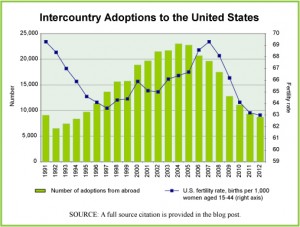The decade between 1995 and 2005 was a high point in adoptions by U.S. citizens of children from other countries, as can be seen in the graph. Since then, the numbers of adoptions has plummeted despite growing waiting lists of U.S. citizens interested in adopting. The reasons for the decline are varied but explained this way in a report by Time magazine, “… a combination of forces in the developing world, from reform efforts to economic growth to resurgent nationalism, is turning the attitude against the practice, even in countries where kids may need the most help.”
Today’s market size, we use the term market loosely here, is the number of children adopted by U.S. citizens from abroad in 2004 (the peak year for intercountry adoptions) and 2012. The graph shows the number of children adopted in this way each year from 1991 through 2012 as well as the fertility rate in the United States for each of these years. The fertility rate is the number of children born for every 1,000 women of childbearing age, namely 15 to 44 years.
Geographic reference: United States
Year: 2004 and 2012
Market size: 22,991 and 8,668 respectively
Source: Kayla Webley, “The Baby Deficit,” Time, January 21, 2013, page 34. “Statistics – Adoptions by Year,” a report put out by the U.S. State Departments’ Bureau of Consular Affairs and available online here. “International Adoption Facts,” a report published by The Evan B. Donaldson Adoption Institute in 2002 and available online here. “National Vital Statistics Reports — Births: Final Data for 2010, August 28, 2012, U.S. Department of Health and Human Services, Centers for Disease Control and Prevention (CDC), available online here, with updates from another CDC report available here.
Posted on February 1, 2013

